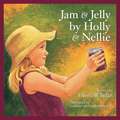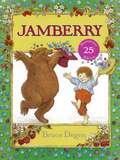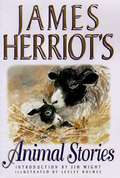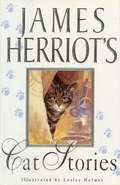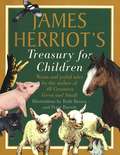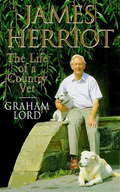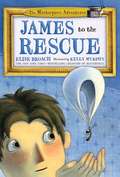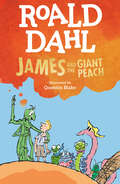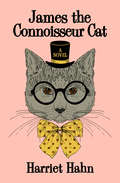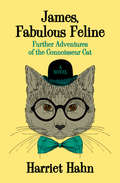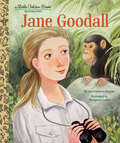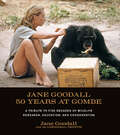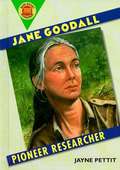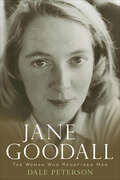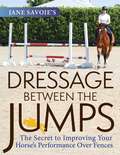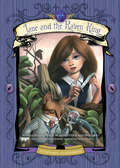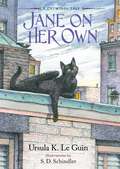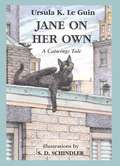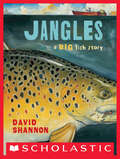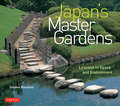- Table View
- List View
Jam and Jelly by Holly and Nellie
by Gloria WhelanHolly's family lives a simple life in northern Michigan, enjoying the bounty of the earth and very much in step with the rhythm of the changing seasons. But times are hard and a cold winter is coming. Without a warm coat, Holly might not be able to start school. Readers will delight in Mama's solution to Holly's predicament.
Jamberry
by Bruce DegenHatberryShoeberryIn my canoeberryUnder the bridgeAnd over the damLooking for berries Berries for jam They're off...a boy and an endearing, rhyme-spouting bear, who squires him through a fantastic world of berries. And their adventure comes to a razzamatazz finale under a starberry sky. Children will want to feast again and again on Bruce Degen's exuberant, colorful pictures and his rollicking, berryful rhymes. HatberryShoeberryIn my canoeberyUnder the bridgeAnd over the damLooking for berriesBerries for jam They're off...a boy and an endearing, rhyme-spouting bear, who squires him through a fatastic world of berries. And their adventure comes to a razzamatazz finale under a starberry sky. Children will want to feast again and again on Bruce Degen's exuberant, colorful pictures and his rollicking berryful rhymes.
James Herriot's Animal Stories
by James HerriotFew authors in memory have delighted readers around the world thoroughly as the beloved veterinarian James Herriot. And, with his recent volumes of hugely popular illustrated tales—James Herriot's Cat Stories and James Herriot's Favorite Dog Stories—his name has been introduced to a whole new generation of readers. Now, this gorgeous new collection finally brings together ten of his best-loved stories celebrating all the creatures in his wonderful world—creatures bright and beautiful, great and small. Here are lambs, horses, cows, dogs, even a whimsical pig or two, along with their colorful human counterparts—all brought vividly to life by Herriot's storytelling magic. From a prickly horse young James encountered early in his veterinary-school experience, through Dorothy the goat—star of the entrancing holiday tale "There's Christmas—and Christmas"—we are reacquainted with all the charming companions of Herriot's Yorkshire menagerie. Once again illuminated by the radiant watercolors of Lesley Holmes, each of Herriot's animal friends is rendered with the kind of warmth and humor that comes with old, familiar friendship. With a special introduction by Herriot's own son Jim, the stories in this bright new collection will warm readers of every age.
James Herriot's Cat Stories
by James HerriotKittens and cats of all kinds abound in this book and, like their flesh-and-blood counterparts, they will purr their way into the hearts and minds of everyone who hears their stories. This warm and joyful volume of stories collects some of the Yorkshire vet's favorite tales about one of his favorite animals―each memoir as memorable and heartwarming as the last.
James Herriot's Dog Stories
by James HerriotFrom the Book Jacket "[Herriot has the] ability to touch readers with his stories of pets and their eccentric owners and to bring them into the harshly beautiful world of the Yorkshire dales." -Chicago Tribune "FIFTY TOUCHING AND MEMORABLE DOG STORIES FROM THE VETERINARIAN AND MASTER STORYTELLER OF YORKSHIRE . . . AN EXTRA SPECIAL TREAT!" -Kirkus Reviews "Herriot's real gift lies in keeping us intrigued with his human and dog characters . . . Herriot teaches us how unpredictable and joyous life can be." -San Francisco Chronicle "James Herriot has become one of America's most beloved storytellers." -Times-Dispatch (Richmond, VA)
James Herriot's Treasury for Children: Warm and Joyful Tales by the Author of All Creatures Great and Small
by James Herriot Ruth Brown Peter BarrettJames Herriot's Treasury for Children collects all of the beloved veterinarian's delightful tales for young readers. From the springtime frolic of Oscar, Cat-About-Town to the yuletide warmth of The Christmas Day Kitten, these stories-radiantly illustrated by Peter Barrett and Ruth Brown-are perennial favorites, and this new complete edition will make a wonderful gift for all readers, great and small.
James Herriot: The Life of a Country Vet
by Graham LordAlf Wight, a modest Scottish writer, better known as James Herriot, wrote books that became worldwide best sellers, films, audiobooks, and a much-loved television show. In The Life of a Country Vet, Graham Lord has written a detailed and affectionate biography of this remarkable man. Lord carefully documents Wight's life, beginning with his childhood in Glasgow and his years in veterinary college. Following his development as a writer, the source of his pen name, and his struggles to get published. Along the way, we encounter some extraordinary events and hidden tragedies in this seemingly magical life. Millions of fans laughed and cried at Wight's delightful stories of life as a vet. Lord reveals that some of the stories were utterly true, and some were utterly fictional. He illuminates the real relationships between the memorable characters that inhabit the books. This warm yet insightful portrait by Lord - who knew his subject very well - will be enjoyed by Wight's myriad of fans. It also dispels the myths that have grown around the life of one of the most famous and deeply loved vets the world has known.
James Herriot: The Life of a Country Vet
by Graham LordAlf Wight, a modest Scottish writer, better known as James Herriot, wrote books that became worldwide best sellers, films, audiobooks, and a much-loved television show. In The Life of a Country Vet, Graham Lord has written a detailed and affectionate biography of this remarkable man. Lord carefully documents Wight's life, beginning with his childhood in Glasgow and his years in veterinary college. Following his development as a writer, the source of his pen name, and his struggles to get published. Along the way, we encounter some extraordinary events and hidden tragedies in this seemingly magical life. Millions of fans laughed and cried at Wight's delightful stories of life as a vet. Lord reveals that some of the stories were utterly true, and some were utterly fictional. He illuminates the real relationships between the memorable characters that inhabit the books. This warm yet insightful portrait by Lord - who knew his subject very well - will be enjoyed by Wight's myriad of fans. It also dispels the myths that have grown around the life of one of the most famous and deeply loved vets the world has known.
James To The Rescue (The Masterpiece Adventures #2)
by Elise Broach Kelly MurphyIn this Masterpiece Adventure, the second in a chapter book series for younger readers from Elise Broach, bestselling author of Masterpiece, Marvin the beetle is going collecting with his family. All is good and well until Uncle Albert gets hurt. Marvin needs James's help to save Uncle Albert before it's too late. James to the Rescue captures the miniature world of Marvin the beetle and his special friendship with James.
James and the Giant Peach
by Roald DahlFrom the World's No. 1 Storyteller, James and the Giant Peach is a children's classic that has captured young reader's imaginations for generations.One of TIME MAGAZINE&’s 100 Best Fantasy Books of All TimeAfter James Henry Trotter's parents are tragically eaten by a rhinoceros, he goes to live with his two horrible aunts, Spiker and Sponge. Life there is no fun, until James accidentally drops some magic crystals by the old peach tree and strange things start to happen. The peach at the top of the tree begins to grow, and before long it's as big as a house. Inside, James meets a bunch of oversized friends—Grasshopper, Centipede, Ladybug, and more. With a snip of the stem, the peach starts rolling away, and the great adventure begins! Roald Dahl is the author of numerous classic children&’s stories including Charlie and the Chocolate Factory, Matilda, The BFG, and many more! &“James and the Giant Peach remains a favorite among kids and parents alike nearly 60 years after it was first published, thanks to its vivid imagery, vibrant characters and forthright exploration of mature themes like death and hope.&” —TIME Magazine
James the Connoisseur Cat: A Novel (The Connoisseur Cat #1)
by Harriet HahnThe delightful crime-solving and aristocratic social adventures of an American antiques expert and a British feline with finesse It&’s love at first sight when a businessman visiting London meets a silver-gray cat named James in the lobby of his apartment house. The two begin meeting regularly for cocktails—single-malt whiskey, neat, for James—and attending posh parties, where James first makes a name for himself by cracking the case of a priceless jewel scam. Soon James is on the prowl, deterring pickpockets on the subway and ferreting out stamp forgeries and counterfeit paintings. In between crime capers, he screens potential tenants, spends the holidays at an ancestral estate in Devon where the crème de la crème of British society anoints him Sir James, and indulges in his penchants for pâté de fois gras and matchmaking with inimitable panache.James the Connoisseur Cat is the 1st book in the Connoisseur Cat novels, but you may enjoy reading the series in any order.
James, Fabulous Feline: Further Adventures of the Connoisseur Cat (The Connoisseur Cat #2)
by Harriet HahnThe excellent adventures of the aristocratic British feline continue as James puts his best paw forward to solve crimes while indulging in the finer things in life James is enjoying life at Baron&’s Chambers, the London apartment house where he shares a flat with his sometime handler, an American fine arts agent. But his deductive abilities will be put to the test when he&’s called on to detect philatelic forgeries at Thwaites, one of the city&’s great auction houses. The recently knighted cat also finds time to coach a croquet team, oversee rehearsals of a sequel to Cats, and help deliver a baby. Not to be outdone by cheesy actors or blundering attorneys, he makes his film debut and testifies in a criminal trial at the Old Bailey. But he has a special place in his heart for St. James&’s Palace, the address he longs to call home. This delightful sequel to James the Connoisseur will prove irresistible catnip for feline lovers.James, Fabulous Feline is the 2nd book in the Connoisseur Cat novels, but you may enjoy reading the series in any order.
Jamie's Discovery
by Betty RolandJamie's dog Fran is gone! Is she lost or did the old "hatter" take her? Jamie has almost given up the search--then comes his big discovery!
Jane Goodall y los chimpancés (¡Arriba la Lectura!, Big Book Unit 3 #7)
by Pamela Chanko Betsey ChessenNIMAC-sourced textbook
Jane Goodall: A Little Golden Book Biography (Little Golden Book)
by Lori Haskins HouranHelp your little one dream big with a Little Golden Book biography about primatologist and conversationist, Jane Goodall. Little Golden Book biographies are the perfect introduction to nonfiction for young readers—as well as fans of all ages!This Little Golden Book about Dr. Jane Goodall--the world's leading expert on chimpanzees and founder of the Jane Goodall Institute, which protects chimpanzees and their habitats--is an inspiring read-aloud for young animal lovers.Look for more Little Golden Book biographies: • Misty Copeland • Frida Kahlo • Iris Apfel • Bob Ross • Queen Elizabeth II • Harriet Tubman
Jane Goodall: A Tribute to the Five Decades of Wildlife Research, Education, and Conservation
by Jane GoodallAn updated, photo-filled account of a half century working with chimpanzees in East Africa by the renowned primatologist.In honor of the field site’s fiftieth anniversary, Jane Goodall: 50 Years at Gombe is a compelling pictorial tribute to Dr. Goodall’s life, her studies of chimpanzee behavior, and her unflagging efforts to motivate people to make this world a better place. With new photographs and updated text throughout, this revised edition retraces five decades of compassion and discovery.Though the book covers a half century, the accomplishments of the past ten years alone have given the Jane Goodall Institute a great deal to celebrate. Recounted are endeavors at the Gombe field site including landmark research related to AIDS progression; establishing programs to improve sanitation, health care, and education in neighboring Tanzanian communities; and partnering with local people to pursue reforestation initiatives.
Jane Goodall: Pioneer Researcher
by Jayne PettitA biography of the famous zoologist focusing on her work with the chimpanzees at the Gombe Stream Reserve in Tanzania.
Jane Goodall: The Woman Who Redefined Man
by Dale PetersonA biography of the primatologist that “vividly and significantly enriches our understanding of Goodall”—includes photographs (Booklist, starred review).This essential biography of one of the most influential women of the past century shows how truly remarkable Jane Goodall’s accomplishments have been. Goodall was a secretarial school graduate when Louis Leakey, unable to find someone with more fitting credentials, first sent her to Gombe to study chimpanzees. In this acclaimed work, Dale Peterson details how this young woman of uncommon resourcefulness and pluck would go on to set radically new standards in the study of animal behavior. He vividly captures the triumphs and setbacks of her dramatic life, including the private quest that led to her now-famous activism.Peterson, a longtime Goodall collaborator, has a unique knowledge of his subject. Candid and illuminating, this work will be a revelation even to readers who are familiar with the public Goodall as presented in her own writing.“Peterson provides colorful descriptions of day-to-day life at Gombe and Goodall’s interaction with the chimps, and ably portrays her relationship with Leakey, the National Geographic Society (which sponsored much of her work), her two marriages, her reaction to her celebrity and her ventures as an activist for the well-being of chimpanzees.” —Publishers Weekly“Captures the spirit of a remarkable woman in science.” —Library Journal (starred review)
Jane Savoie's Dressage Between the Jumps
by Jane SavoieA compelling collection of focused flatwork exercises for improving jumping performance. Renowned author and mental training coach Jane Savoie breaks down the six most common problem areas she sees when horses jump: “Whoa” and “go” Rhythm Suppleness through the poll, neck, body, back, and hindquarters Contact and connection Collection Flying changes Then Savoie fills the rider’s toolbox with targeted exercises on the flat―simple solutions to the nagging problems that prevent riders and horses from doing their best over all kinds of obstacles, whether competing in hunters, jumpers, equitation, or eventing. Her excellent lessons gradually incorporate ground poles and low fences to build skills without stressing the horse’s body. Throughout, top riders share their own stories and insight, demonstrating numerous ways dressage exercises helped solve real problems over fences, including Olympian Anne Kursinski, Nations Cup rider Paul O’Shea, and eventer Nancy Bliss Byrd. With incredible clarity and her trademark enthusiasm, Savoie arms readers with knowledge, confidence, and problem-solving prowess that will result not only in clear rounds, but a happier horse, ready and willing to perform in partnership.Jane Savoie was the first to promote mental training tools and techniques as integral to competitive riding success, and her cross-training concepts for the horse-how to use dressage fundamentals for every equestrian sport-have been called “not just a read, but a must read for every hunter-jumper rider.”
Jane and the Raven King
by Stephen ChambersOutside the window, a squirrel in a tree popped out with a little black suitcase. At first, Jane was sure she must be mistaken, but as she watched, the squirrel opened the tiny suitcase and began arranging nuts and acorns inside. . . <P><P>The animals clearly knew something was wrong. Even her pet iguana scrawled a warning in the sand of his tank: He is coming. <P><P>Soon all the animals are fleeing the suburb where Jane lives. But they aren't the only ones acting strange. Jane's parents seem to be hypnotized by their cell phones and the TV. And her grandma starts controlling the weather and speaking in a funny language. But when Jane meets an old blind man who can drive a car and claims Jane is the only one who can save the world, well, that's when things really start to get weird. . .
Jane on Her Own (Catwings #4)
by Ursula K. Le GuinJane has a city adventure in this fourth book in legendary author Ursula K. Le Guin&’s bestselling Catwings chapter book series, now with a new look!Jane, the youngest of the Catwings, thinks that life on the farm is absolutely boring. Looking for adventure, she takes to the skies to explore all the world has to offer. But when she flies through the window of a friendly-seeming human, Jane finds herself captured—and forced to make TV appearances as Miss Mystery, the fabulous winged cat. How can she possibly explore the world now? Is there anywhere Jane can be truly free?
Jane on Her Own (Catwings Series #4)
by Ursula K. Le GuinJane is restless. What's the use of having wings and being able to fly if she never gets to go anywhere or see anything? "It's too dangerous," says her big sister Harriet. "If human beings saw cats with wings, they'd put us in cages." But Jane refuses to listen. There are adventures waiting beyond the farm, and she is eager to find them. And find them she does. She flies to the city-and through the window of a man who makes her a TV star! But her pampered life is too much like a cage. Brave Jane escapes, to seek new friends, old friends, and true freedom. Book 4 in the Catwings series.
Jangles: A Big Fish Story
by David ShannonBestselling storyteller David Shannon instantly hooks readers with this stunning, highly entertaining tour-de-force--his best book ever!Breathtaking oil paintings bursting with energy pullreaders along into Big Lake, the home of Jangles, thebiggest fish anyone has seen. Fishing alone at dusk,a boy feels a tug on his line and comes face-to-facewith the gigantic trout--whose enormous jaw is coveredwith so many lures and fish hooks that he jingles andjangles when he swims. Terrified by the sight, the boy isshocked when Jangles befriends him and takes him on anadventure to the bottom of the lake. A surprise endingwill leave readers laughing and shaking their heads. Hereis Shannon at his very best-in a wild and witty story thatbegs repeated reading.
Japan's Master Gardens
by Stephen MansfieldNo two Japanese gardens are ever the same. Each is inimitable, yet embodies commonalities of design and aesthetic taste. Each finds the space for innovation within a tradition that benefits from a thousand years of applied knowledge. Presenting twenty-five master gardens, Japan's Master Gardens explores the ingenuity and range of Japanese landscaping, from the self-imposed confines of courtyard designs to the open expanses of the stroll garden.Japan's Master Gardens illustrates how, through the ministrations of generations of gardeners, original landscapes have maintained their mastery and demonstrates how contemporary landscaping draws from tradition, making ancient gardens relevant to the lives of people in the twenty-first century.This beautifully illustrated book takes readers on an exploration of the outward forms, underpinning principles, complex use of metaphor and allusion, and beauty and depth that set the Japanese garden apart.
Japan's Withdrawal from International Whaling Regulation
by Nikolas Sellheim Joji MorishitaThis book examines the impact and implications of Japan's withdrawal from the International Convention for the Regulation of Whaling (ICRW), which came into effect in July 2019. In 1982 the International Whaling Commission (IWC) adopted a moratorium on commercial whaling which has been in effect ever since, despite the resistance of some countries, first and foremost Japan, Norway and Iceland, that engage in commercial whaling. As one of the key contributors to scientific research and funding, Japan's withdrawal has the potential to have wide-ranging implications and this volume examines the impact of Japan's withdrawal on the IWC itself, on the governance of whaling, and on indigenous and coastal whaling. It provides backgrounds and commentaries on this decision as well as normative and legal discussions on matters relating to sustainable use of resources, and philosophies surrounding whaling in different IWC countries. The consideration of other international environmental regimes, such as the Convention on International Trade in Endangered Species (CITES) are also examined in order to determine the international ripple effect of Japan’s decision. The book reveals that this is not just a matter of whaling but one which has significant legal, managerial and cultural implications. Drawing on deep analyses of IWC structures, the book addresses core philosophies underlying the whaling debate and in how far these may influence environmental governance in the future. This book will be of great interest to students and scholars of environmental law and governance, biodiversity conservation and sustainable development, as well as policymakers involved in international environmental and conservation agreements.
